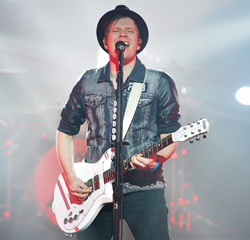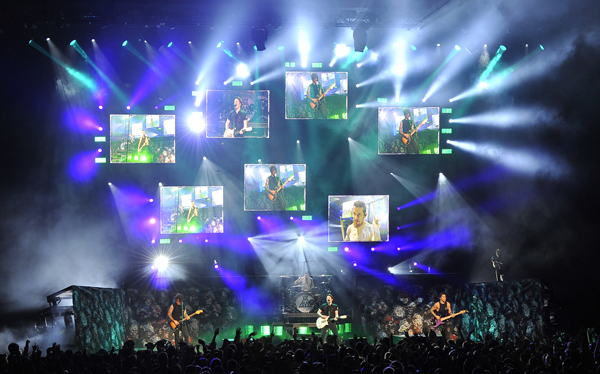
Hara used a single mic on each amp, positioned at the center. Bass was taken direct via a Tech 21 SansAmp, with no amp cabinet on stage.
The drum kit was captured with a largely rock n’ roll approach. A BETA 91A was inside the kick and a BETA 52A was in the hole, with Olech applying a bit of Waves InPhase plug-in at front of house to put the two in sync.
A dual mic method was also taken on snare, with a BETA 56A on top and a KSM32 on bottom, and they were also phase aligned with an assist from the plug-in. “The Waves tool makes a world of difference,” Olech notes.
BETA 98A miniature cardioid condensers were applied to the toms, another mic drawing high praise from Olech. Meanwhile, overheads were technically underheads, with KSM137 end-address condensers positioned closely under both of Hurley’s crash cymbals. The same went for ride and hi-hat.
Keeping It Simple
Both engineers did their mixing on Avid VENUE Profile consoles that have been another tour staple. Neither goes over-the-top in terms of processing, with Olech noting that he utilized Phoenix CraneSong as well as Waves C6 and SSL ChannelStrip plug-ins to tailor Stump’s vocal mix, completing it with a bit of reverb and delay.
Hara inherited the previous show file, and stripped back the processing to an extent. The goal was keeping each monitor mix tight and with minimum latency. “These guys want to keep it simple, have their own instrument and vocal on top of their monitor mix, and everything else significantly below that,” he explains. “Other than that, there’s some click and stereo backing track blended in, and that’s it.”
The Fall Out Boy stage was devoid of loudspeakers – not a wedge, side fill or even drum “thumper” to be found. It helped keep down overall noise and wash, contributing to a very clean, distinct sonic signature in the house.
All of the musicians wore JH Audio JH16 Pro in-ear monitors fed by Shure PSM 1000 wireless personal monitoring systems. Hara is forthcoming in his praise of the PSM 1000s. “They’re the most solid systems in terms of RF that I’ve ever worked with, and provide excellent sound that can be punchy when you want it,” he says. “At this time they’re really hard to beat.”
Hara was responsible for all RF coordination on the tour, with more than 30 active channels (plus spares) to get in line at each stop. This included the Shure guitar wireless systems favored by Wentz (UR4D), Stump (also UR4D) and Trohman (ULXD4Q). He performed frequency scans prior to each show, utilizing the Shure Wireless Workbench platform and Axient 600 spectrum manager to help get it all coordinated.
Exceptionally Strong
Hara and Olech both enjoy long-standing working relationships with Clair, further aligning their goals and those of the band.
Clair provided i5 full-range line array modules joined by i5b low-frequency array modules, typically deployed 12 per side to cover the amphitheatres and arenas visited by the tour. Lower octaves were reinforced by 24 BT-218 dual-18-inch subwoofers on the deck.
Olech notes that the draw at each venue was exceptionally strong, with mostly sold-out shows. “It’s kind of interesting,” he concludes. “The band went away for a few years and actually managed to grow their fan base when they returned. They’re also a real pleasure to work with, and our vendor support was amazing. That kind of enthusiasm makes for a great tour.”


